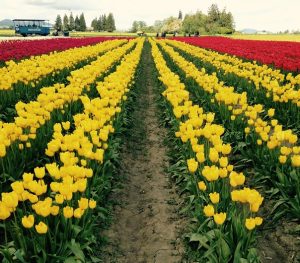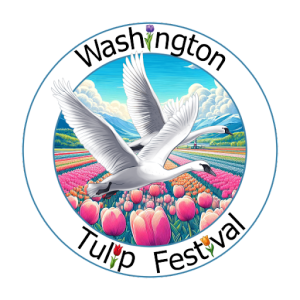Title: "Floral Legacy Blooms: A Comprehensive History of the Commercial Flower Bulb Industry in Washington State"
 is a captivating journey through time, marked by resilience, innovation, and the emergence of a flourishing industry that has become synonymous with the region's natural beauty. Let's delve into the exhaustive history of tulip cultivation in this beautiful corner of the United States.
is a captivating journey through time, marked by resilience, innovation, and the emergence of a flourishing industry that has become synonymous with the region's natural beauty. Let's delve into the exhaustive history of tulip cultivation in this beautiful corner of the United States.
George Gibbs and the Orchards of Orcas Island (1883): Our story begins around 1883 when George Gibbs, a determined English immigrant, settled on Orcas Island in Washington State. Initially focusing on apple and hazelnut cultivation, Gibbs's curiosity led him to invest a mere five dollars in flower bulbs in 1892. When these bulbs multiplied miraculously, he recognized the potential for bulb-growing in the Puget Sound region.
The Dutch Connection and Secrecy: Undaunted by his initial success, George Gibbs sought to deepen his knowledge of the flower bulb business. He reached out to Dutch growers in Holland, world-renowned for their tulip expertise. However, he soon discovered the Dutch well-guarded their secrets regarding their commercial practices. Nevertheless, Gibbs's determination prevailed, and he decided to ship a few bulbs to Holland, astonishing Dutch growers who subsequently made the journey to Orcas Island to witness tulips thriving beyond the borders of Holland.
United States Department of Agriculture (USDA) Involvement (1899): In 1899, George Gibbs wrote to the United States Department of Agriculture (USDA), expressing his keen interest in the commercial prospects of bulb-growing in the Puget Sound region. The USDA, intrigued by his findings, decided to take part. In 1905, they sent Gibbs 15,000 imported bulbs from Holland as part of an experimental contract.
USDA Test Garden and the Birth of the Bellingham Tulip Festival (1908): The experiment with imported bulbs from Holland yielded tremendous success. In 1908, the United States Department of Agriculture established its own 10-acre test garden around Bellingham, firmly establishing the region's potential for tulip cultivation. This achievement paved the way for the inauguration of the Bellingham Tulip Festival in 1920, celebrating the burgeoning bulb industry's triumphs.
Discontinuation and Migration to Skagit County (1930): Unfortunately, the Bellingham Tulip Festival faced a period of discontinuation in 1930, primarily due to the Great Depression and a series of devastating bulb freezes in 1916, 1925, and 1929, which inflicted significant losses upon the growers. Consequently, many bulb cultivators opted to relocate southward to Skagit County, heralding a new chapter in Washington's tulip-growing history.
The Floral Tapestry of Skagit County: Skagit County, nestled in the heart of Washington State, has been graced by breathtaking floral displays that captivate visitors from near and far. However, one vibrant piece of this floral tapestry has slipped into the annals of history—the resplendent blue Dutch iris that once adorned Skagit County's landscapes.
Neil Noorlag, often hailed as the father of the Skagit Valley Bulb industry, introduced the art of cultivating iris and daffodils to the fertile lands of the region. Noorlag started in the 1930s growing primarily Dutch iris, he agreed to sell iris seed stock to Glen Darst of Whidbey Island. He then sponsored Hank DeGoede and Bill Roozen from Holland, passing on his expertise and passion in 1945.
Earle Darst emerged as a giant in Skagit County's floral history, becoming the largest grower of flower bulbs in the United States. Specializing in Dutch iris, daffodils, and gladiolas, Darst's contributions were immeasurable. In 1938, his family started Darst Bulb Farms, which became Washington's oldest continuous flower growing farm, harvesting bulbs with the first mechanized digger/harvester that he invented. Beyond his impressive flower-growing endeavors, Darst also made history as Washington's first Bulb Commissioner. Darst was a commercial hybridizer of iris producing a blue iris, Deep Velvet and a lemon yellow, called Enchantress. His legacy lives on through the vibrant blooms that still grace Skagit County today.
Bill Roozen, carrying forward the traditions of his predecessors, established the Washington Bulb Company in 1955. Today, his farm is now the largest grower of flower bulbs in the region, focusing on lilies, daffodils, and tulips. His son's are preserving Skagit County's floral heritage for future generations.
Earle Darst gradually moved all of his iris cultivation to Skagit County starting in Sedro Wooley WA in 1950, expanding to the breath and width of the county to rotate the ground the flowers were grown in.
Washington Tulip Festival, features street fairs, art shows, sporting events, and the captivating beauty of Washington Bulb Company’s fields, Tulip Town, Garden Rosalyn, and Tulip Valley Farms combined with the watching of graceful Trumpeter Swans. The festival has become one of the most cherished floral celebrations in the United States.
Bellingham Tulip Festival (1908) was the first tulip festival in Washington State, but ceased due to three years of devastating freezes prior to 1930.
The Skagit Valley Tulip Festival (1984), initiated by the Mount Vernon Chamber of Commerce in 1984, marked the official Skagit celebration of this blooming paradise. Evolving from a three-day event to a now month-long extravaganza, now known as the Washington Tulip Festival, an all-grower-sponsored event attracting over a million annual visitors from near and far.
Tulip Valley Farms is the newest flower venue featuring multi-floral events, a night show of tulips and more flowers than just tulips. Pick your own flowers has become a delightful destination.
Garden Rosalyn, is a 13 acre complex with lots of parking, and 6 acres of tulips planted in fun designs, including stars, animals and manicured beds.
Roozengaarde, The Washington Bulb Company's retail outlet, now operates a gift shop, a public garden and grows the majority of daffodil and tulip fields that can be viewed from your vehicle.
Tulip Town, established as the original Neil Noorlag farm, was converted to a festival venue by the DeGoede family, and now plays a significant role in the festival's success. Tulip Town is a smaller farm with a retail shop ran by a newer corporation.
 offers official festival posters, mugs, tee-shirts, iris, daffodils, gladiolas, and tulip bulbs for your home and garden, you can purchase now and receive your shipment in the fall after they mature and are dug. Right now they are growing and or sleeping.
offers official festival posters, mugs, tee-shirts, iris, daffodils, gladiolas, and tulip bulbs for your home and garden, you can purchase now and receive your shipment in the fall after they mature and are dug. Right now they are growing and or sleeping.
Challenges and Adaptations: Throughout its history, the flower bulb industry in Washington State has faced its share of challenges. In 2020, the festival encountered the unprecedented obstacle of the COVID-19 pandemic, leading to its cancellation. Despite initial plans for a smaller event, the festival had to be called off following a state government stay-at-home order. Nevertheless, venues like Tulip Town responded with resilience, offering virtual tours and flower donations for hospital workers to mitigate revenue losses.
In conclusion, the history of flower bulb cultivation in Washington State is a story of determination, growth, and adaptability. From George Gibbs' early experiments to the establishment of major festivals and the resilience displayed during challenging times, Washington's flower industry continues to flourish and shape the region's identity. The vibrant blooms of Skagit County's fields and the graceful Trumpeter Swans continue to attract visitors, showcasing the remarkable success of this dynamic industry. Explore the enduring history and captivating beauty of the Commercial Flower Bulb Industry in Washington State, a story that blossoms with each passing season.